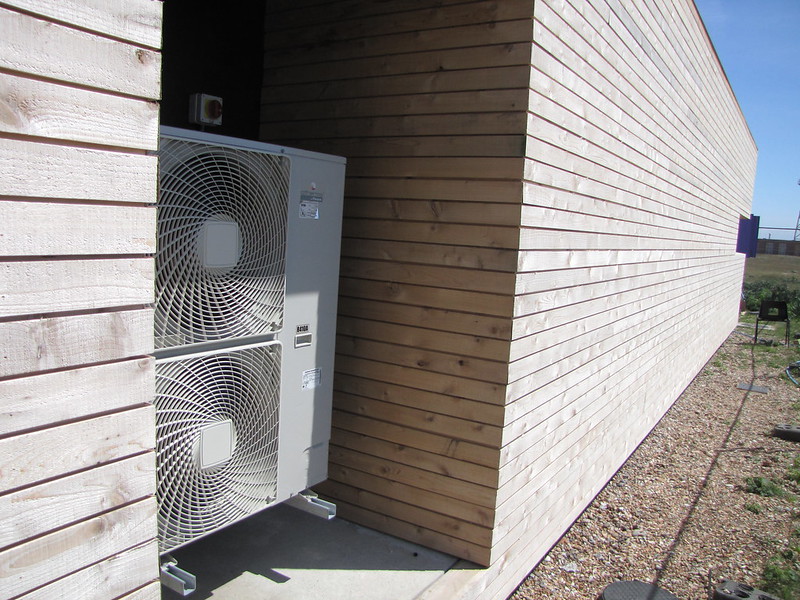A monobloc air source heat pump is a single-unit heat pump that is located outside of the home. It consists of a singular outdoor unit that houses the compressor, heat exchanger, and water-side of the refrigeration cycle. This is in contrast to a split heat pump, which utilizes multiple units with both an indoor and outdoor component. A monobloc heat pump heats the water externally, while a split system contains the heated water entirely within the house.
Understanding the Anatomy of a Monobloc Heat Pump
A monobloc air source heat pump is a self-contained unit that combines all the essential components of a heat pump system into a single outdoor enclosure. This includes:
- Compressor: The heart of the heat pump, responsible for circulating the refrigerant through the system and generating the necessary pressure differential to facilitate heat transfer.
- Heat Exchanger: Also known as the condenser, this component transfers the heat absorbed from the outside air into the water or heating system.
- Expansion Valve: Regulates the flow of refrigerant, allowing it to expand and cool as it enters the evaporator.
- Evaporator: Absorbs heat from the outside air, causing the refrigerant to evaporate and change from a liquid to a gas.
- Refrigerant Pipes: Carry the refrigerant between the various components, facilitating the heat transfer process.
- Water Connections: Allow the heated water to be circulated throughout the home’s heating system.
Advantages of a Monobloc Heat Pump
-
Easier Installation: Monobloc heat pumps are generally simpler to install than split systems, as they only require a single outdoor unit to be connected to the home’s heating system. This can result in lower installation costs and a quicker setup process.
-
Lower Initial Cost: Monobloc heat pumps are often less expensive to purchase than split systems, making them an attractive option for homeowners on a budget.
-
Compact Design: The all-in-one nature of a monobloc heat pump means that it takes up less space than a split system, which requires both an indoor and outdoor unit.
-
Reduced Maintenance: With fewer components and connections, monobloc heat pumps may require less maintenance and have a lower risk of refrigerant leaks compared to split systems.
Disadvantages of a Monobloc Heat Pump
-
Reduced Efficiency: Monobloc heat pumps may be less efficient than split systems, as the heat exchanger has to work harder to heat the water from the outside air, which can result in higher energy costs.
-
Freezing Concerns: In colder climates, the water in the pipes connecting the monobloc unit to the home’s heating system may be at risk of freezing, potentially causing damage to the system. This can be mitigated by using anti-freeze solutions or installing freeze protection valves.
-
Limited Placement Options: The monobloc unit must be installed outdoors, which can limit its placement options and may require additional considerations, such as noise levels or visual impact.
-
Potential for Noise: The compressor and other components within the monobloc unit can generate noise, which may be a concern for homeowners who prioritize a quiet living environment.
Preparing for a Monobloc Heat Pump Installation
Before installing a monobloc air source heat pump, it’s essential to consider the following factors:
-
Climate and Location: Assess the climate and outdoor conditions where the monobloc unit will be installed. In colder regions, measures to prevent freezing may be necessary.
-
Heating System Compatibility: Ensure that the monobloc heat pump is compatible with your home’s existing heating system, including the type of radiators or underfloor heating.
-
Electrical Requirements: Determine the electrical power supply needed for the monobloc unit and ensure that your home’s electrical system can accommodate it.
-
Plumbing Considerations: Plan the routing of the water pipes connecting the monobloc unit to the home’s heating system, taking into account factors such as insulation, accessibility, and potential freeze points.
-
Noise Levels: Consider the noise output of the monobloc unit and its potential impact on the surrounding area, especially if it will be installed near living spaces or property boundaries.
-
Maintenance and Servicing: Familiarize yourself with the recommended maintenance schedule and servicing requirements for your monobloc heat pump to ensure optimal performance and longevity.
Installing a Monobloc Heat Pump: Step-by-Step Guide
-
Site Preparation: Choose a suitable location for the monobloc unit, ensuring it is level, well-ventilated, and easily accessible for maintenance. Prepare the ground or mounting surface as needed.
-
Electrical Installation: Connect the monobloc unit to the home’s electrical system, ensuring proper grounding and compliance with local electrical codes.
-
Plumbing Connections: Install the water pipes that will connect the monobloc unit to the home’s heating system. Insulate the pipes to prevent heat loss and freezing.
-
Refrigerant Charging: If the monobloc unit requires refrigerant charging, follow the manufacturer’s instructions carefully, using the appropriate tools and equipment.
-
Commissioning and Testing: Once the installation is complete, commission the monobloc heat pump and test its operation to ensure it is functioning correctly and efficiently.
-
Ongoing Maintenance: Establish a regular maintenance schedule, including tasks such as cleaning the air filters, checking refrigerant levels, and inspecting the system for any signs of wear or damage.
By understanding the technical details and following best practices, DIY enthusiasts can successfully install and maintain a monobloc air source heat pump, enjoying the benefits of this energy-efficient heating solution.
Conclusion
A monobloc air source heat pump is a compact, self-contained unit that offers a range of advantages, including easier installation and lower initial costs. However, it’s essential to carefully consider the climate, location, and compatibility with your home’s heating system to ensure optimal performance and longevity. By following the guidelines outlined in this comprehensive guide, DIY enthusiasts can confidently tackle the installation and maintenance of a monobloc heat pump, contributing to a more sustainable and energy-efficient home.

